Apple Scionwood
Welcome to our collection of apple scionwood. We grow over 130 varieties of apples and offer scions for grafting from most of them.
For filtered search - we have apples organized by categories and tags. Use the filter below to select as many categories and tags as you want to narrow down your search. For the most specific results, select just one category and multiple desired tags. Full functionality is coming soon - we are continuing to update each variety with all the correct categories and tags. Feel free to reach out with questions about specific varieties.
Categories:
Cider apples (good for hard ciders)
Dessert apples (also known as snacking apples, good for fresh eating)
Baking/saucing apples (also known as culinary apples, good for canning, preserving, baking, and cooking)
Red Flesh (red or pink flesh on the inside)
Tags:
Cold hardy (good for extreme cold or Northern climates)
Disease-resistant (has moderate to strong resistance to one or more common apple diseases)
Harvest period early, mid, or late
Heat or low-chill tolerant (good for extreme warmer or Southern climates)
Heavy producer
Pollination Groups A through E
Ordering is now open for this season. Order now for shipping between January and April 2025. Questions? Please contact Christina Fordyce at 503-930-8280 or fordycefarminc@gmail.com.
Scion wood is sold by the piece, except for some varieties that are available in bulk quantities of a 20-pack. We always seek to provide sticks that are close to 12” and pencil thickness at the base but every variety grows differently and so thickness varies.
We ship only within the United States. We do not ship internationally. Rootstock does not ship to California.
Return/Refund Policy: We do not offer returns or exchanges on scionwood or rootstock. We have a 30-day return policy on our clippers (must be unused and returned in original packaging. Return label must be requested). If we have made an error on the scionwood variety you have ordered, we will refund or replace the incorrect item. Claims for errors in your order must be presented within 30 days of receipt of your order. Claims must include a picture of the error and sent to us by email at fordycefarminc@gmail.com. Failure to assert claims within 30 days after order receipt renders this warranty null and void.
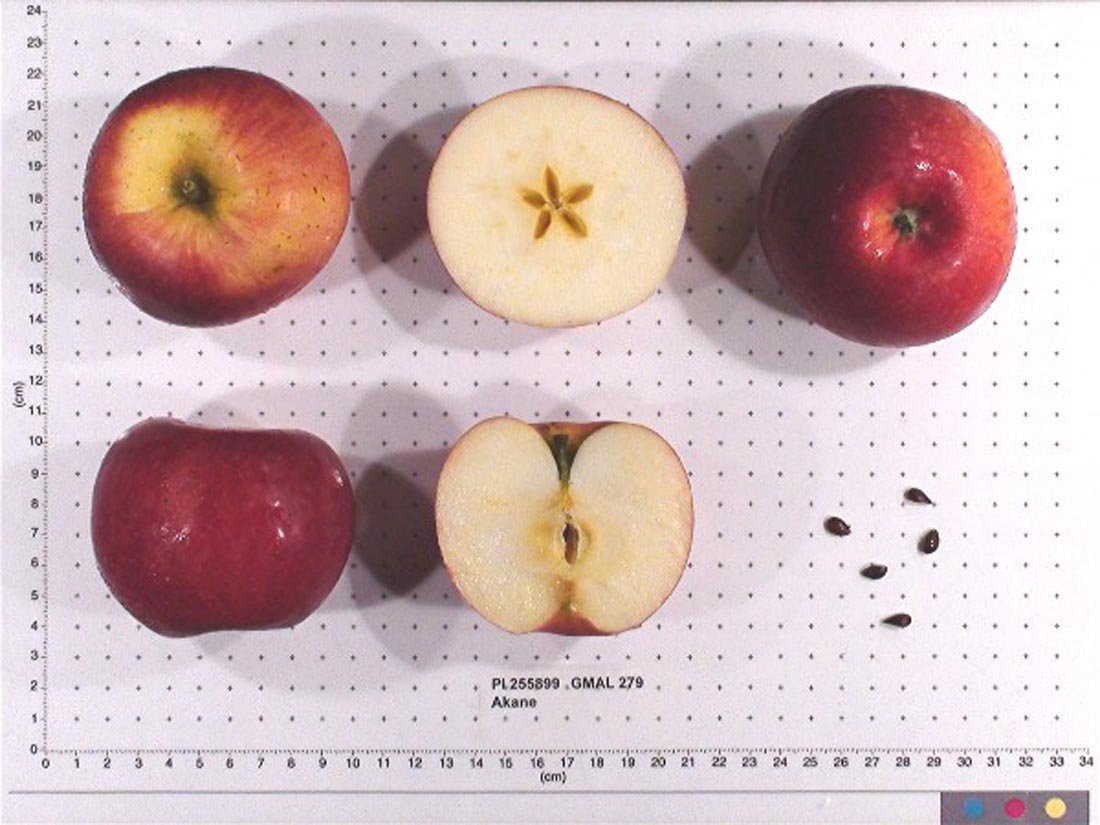
This apple was developed in Japan in the mid-1900s - also known as Tohoku 3. These red apples are on the smaller side but packed with flavor when harvested just right. They hang well on the tree so it’s best to harvest as late as possible for enhanced flavor. They don’t keep as long in cold storage so are best for eating right away. Great for fresh eating, this apple is also fantastic in sauces, pies, and dried. Late harvest period.
Note: this apple scionwood is harvested from Fordyce Farm inc. that we operate in Salem, OR. Fordyce Farm inc. is not certified organic.
Categories: dessert apple, baking/saucing apple
Tags: Disease-resistant, Harvest period mid, Pollination Group D

This apple originated in the Ukraine in the 1700s. It made it’s way to the U.S. in the 1800s and over the Oregon trail to Oregon in the mid-1800s among the first named varieties brought here. It’s a lovely and tasty apple that has a fair amount of disease resistance. Ours grow in an non irrigated part of the orchard and survived hot dry summers with ease. Generally they produce only enough for our use so we don’t often stock scionwood for these.

Red-fleshed, dark red skin these apples are in high demand from both chefs and canners. These have the flavors of raspberries and blackberries in them and are relatively tart. These ripen in mid-August and have the best disease resistance of our red-fleshed apples. We have had relatively good success grafting these but not 100% success. Scion pieces tend to be slightly skinnier than a pencil.
Categories: Red Flesh, dessert apple, cider apple, baking/saucing apple
Tags: Disease-resistant, Harvest period early, Pollination Group D

Ambrosia are a sweet, late season apple. They are quite susceptible to scab. When added to fresh cider, even in amounts as low as 10% they give a lovely creamy consistency. The came out of British Columbia in the 1990s.
Categories: dessert apple
Tags: Harvest period late, Pollination Group D

READ FULL DESCRIPTION. These apples with nearly black skin are from Bentonville, Arkansas and the 1870s. We think the ones from our orchard have a distinctly spicy flavor. These are coveted by cider makers for their complexity and intensity. These are very late season apples. These trees are slower growing and we have a small number of them so scion wood is limited and tends to be smaller than average.
NOTE ABOUT ORDERING: Some pieces we have in stock on this variety are only about 4” long. We usually try to cut a foot long piece, but these are slow growing and we usually sell out of the long pieces. The small pieces are still big enough to graft, but we are offering them at a discounted price because of the smaller-than-standard sizing.
Categories: cider apple, baking/saucing apple
Tags: Harvest period late, Pollination Group D, Disease-resistant

From Gloucester, England and the 1700s. Rowan Jacobson describes the flavor of these as “like a tart homemade lemonade.” He suggests you wait until December to eat these but that depends entirely on how much you like tartness in an apple. These highly russetted apples are reasonably disease resistant. The trees are both productive and vigorous. The scion from them tend to be thicker than a pencil.
Categories: dessert apple, cider apple, baking/saucing apple
Tags: Disease-resistant, Harvest period late, Pollination Group D

This is an old American variety from the 1750s and Massachusetts. It’s a flavorful apple that is also fairly disease resistant and reasonably productive. It was a very popular apple in New England until a terrible freeze in the 1930s wiped out many of the trees. We’ve found this apple to be very resilient in the Pacific Northwest. The scion wood is average and we’ve had great success grafting this apple.
Categories: dessert apple, cider apple
Tags: Disease resistant, Heavy producer, Harvest period late, Pollination Group D

Originally found as a wild seedling in Switzerland in the 1880s. This is a good, medium sized dessert apple. Yellowish green under a deep red. This variety can tend to be biennial. Responds well to pruning.
Categories: baking/saucing apple, dessert apple
Tags: Harvest period late, Pollination Group D

From 1740 England. We love their intense flavor, nuttiness and bit of spice. In England these are popular for apple charlotte. It is one of the parents of the legendary Cox Orange Pippin. These produce every other year but their apples are almost always perfect. They resist all the fungal diseases here. We’ve had success grafting them. They are a very late apples, among the last to ripen in our orchard.
Categories: dessert apple, baking/saucing apple
Tags: Disease-resistant, Heavy producer, Harvest period late, Pollination Group D

Bramley’s Seedling: this is a classic English cooking apple. They are great for growers as they’re productive, vigorous trees. The apples are very resistant to disease and often grow quite large. They really are among the best apples anywhere for sauce and pies. The scion wood is hardy and fairly thick. We have bulk quantities of the scionwood. Contact us for pricing on orders over 60 pieces.
Categories: baking/saucing apple, cider apple
Tags: Disease-resistant, Heavy producer, Harvest period mid, Pollination Group D

From Normandy, France 1598. These are prized by French chefs for baking. Hard, crunchy and intensely lemony. These are late season apples with a lovely lobed shape. They make a wonderful single varietal cider. We find these apples modestly challenging to grow organically being somewhat susceptible to scab and scale. We have had much success grafting this variety.
Categories: baking/saucing apple, cider apple
Tags: Harvest period late, Heavy producer, Pollination Group D
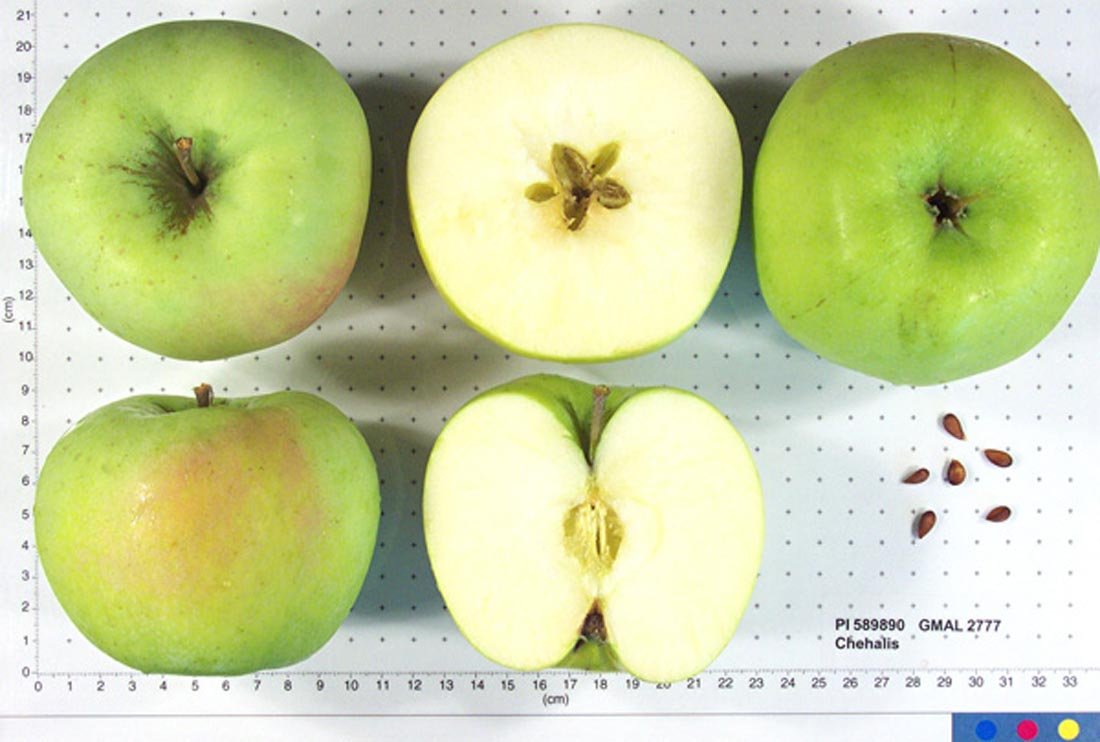
These originated in the 1930s from a seedling of a Golden Delicious raised by Lloyd Lonburg of Oakville, WA - so these are a PNW native! They bruise easily, so handle them with care! Great for fresh eating and pies. Lasts about 2 months in cold storage.
Note: this apple scionwood is harvested from Fordyce Farm inc. that we operate in Salem, OR. Fordyce Farm inc. is not certified organic.
Categories: dessert apple, baking/saucing apple
Tags: Disease-resistant, Heavy producer, Harvest period early, Pollination Group D

These apples look and taste a little quince like. They are coveted for cooking but are also tasty as a sliced up dessert apple paired with a nice cheese. They hold reasonably well and so you can display them in a bowl for a while before eating them. These tend to ripen over several weeks. We pick them from early August into September. They have decent disease resistance and are productive every year. Excess heat can make them drop their fruit early. We’ve found them quite easy to graft.
Categories: dessert apple, baking/saucing apple
Tags: Harvest period early, Pollination Group D

A modern apple from Germany, this is a cross of three of our other apples, Cox Orange Pippin, Duchess of Oldenburg and Golden Delicious. It doesn’t look like any of them, being more pointed than all of them with a creamy background and some rose red striping. It’s odd that this apple has as mild a flavor as it does and that, unlike its parents, grows well in hotter, drier climates. The scion wood tends to be skinnier than most.
Categories: dessert apple
Tags: Heat/low-chill tolerant, Harvest period late, Pollination Group D

From Cornwall and introduced in 1813. They are noted for the aromatic flavor that contains a hint of clove. The word Gilliflower comes from the French word for clove.
Categories: Dessert apple
Tags: Harvest period mid, Pollination Group D, Heat/low-chill tolerant
Bitter, disease resistant cider apple. A highly favored bitter cider apple. These are flavorful and disease resistant. The trees are slow growing and biannual bearing. The produce very few pieces of scion wood each year.
Categories: cider apple
Tags: Disease-resistant, Heavy producer, Harvest period late, Pollination Group D
It originated in the U.K. in 1949 and is likely from a seedling of the Worcester Pearmain. It was first named Thurston August for the town of a nursery it was raised in and for the month it could produce, being an earlier variety. It was renamed to Discovery in the 60s. This delicious apple has a sweet tart flavor some also describe as strawberry-like. Very slow to oxidize when slices exposed to air.
Categories: baking/saucing apple, dessert apple
Tags: Pollination Group D, Disease-resistant, Harvest period early
This is a modern apple that has many wonderful qualities. Great disease resistance, good flavor and firmness. Known for their ability to keep for months in a modern fridge. Late October ripening. Our trees of these are fairly young but we’ve found them to be fast growers that produced quite young. Our top grafted trees produced more than 50lbs each on their third year.
Categories: dessert apple
Tags: Disease-resistant, Heavy producer, Harvest period late, Pollination Group D
This is famous as Thomas Jefferson’s favorite apple. It’s from New York and the early 1800s. This rich, firm fleshed apple is full flavored. Its spicy taste makes it one of our favorites, it’s susceptibility to every disease apple trees can get makes it an ongoing challenge. Dark almost orange/red apples that aren’t perfect but are delicious. These will keep and are famous for being best in late December.
Categories: dessert apple, cider apple, baking/saucing apple
Tags: Harvest period mid, Pollination Group D
We offer two different Fuji apple mutations.
FUJI YATAKA: Late maturing, sweet, crisp, dense-fleshed apples. From Japan and introduced into the U.S, market in the 1980s. Yataka mutation ripens a month earlier than the traditional Fuji. Scab prone and needing careful thinning and pruning. Needs a long, warm ripening period.
FUJI JUBILEE: The marker is that it will bear about two weeks before Fuji Yataka. Fuji Jubilee is also marketed as September Wonder, which is when they first began to ripen in our orchard. It’s a mutation of the Yataka.
Categories: dessert apple
Tags: Harvest period late, Pollination Group D
We take Golden Delicious scion only from the oldest trees on our orchard. These large, standard, over 60 year old trees produce apples that are noticeably richer in flavor than the younger, under 20 year old, trees. It’s unclear if this is the result of genetic differences that come from years of selection or if the large, old trees access nutrients not available to the others. A dead, ripe Golden Delicious is an amazing apple and as commercial ones are picked much too early for any real flavor it’s only experienced by those with these historic trees.
Categories: dessert apple, cider apple, baking/saucing apple
Tags: Cold hardy, Harvest period late, Pollination Group D
Discovered in 1790 and so loved that there is a monument to the first Golden Grimes tree at its home in West Virginia. A delicious apple that also was a favorite among cider makers and moonshiners. Still fairly common in the south. Green apples that a turn a lovely yellow. They are a mixed bag in terms of disease resistance.
Categories: cider apple, dessert apple, baking/saucing apple
Tags: Disease-resistant, Heat/low-chill tolerant, Southern US Roots, Harvest period mid, Pollination Group D
The original strain of the worlds most widely grown apple. These were “improved” to create the famous Red Delicious but we, and many others, believe that the original is a better tasting apple. It’s striped instead of solid red but it has that distinctive delicious shape. From 1870s Iowa. This is another one of the apples that handled the blazing heat of 2021, temps reaching 115, well without any protection.
Categories: dessert apple
Tags: Pollination Group D, Disease-resistant, Heat/low-chill tolerant, Harvest period mid
A cross between Jonathan and Golden Delicious. Bred in New York in 1953. This is one of the more common commodity apples. Large, sweet, fairly mild fruit that are mid to late season ripening. They are fairly scab prone and so can be challenging for organic growers and wet climates.
Categories: dessert apple, cider apple
Tags: Heavy producer, Cold hardy, Harvest period late, Pollination Group D
The most well-known creation of Piet de Sonnaville and not that old, released in 1949. It’s a child of the Cox Orange Pippin but with a more aromatic nature. One of our absolute favorites. We love almost everything about this apple from its overall decent disease resistance to its productivity and its amazing flavor. We’ve had good results grafting this.
Categories: dessert apple, baking/saucing apple, cider apple
Tags: Disease-resistant, Heavy producer, Cold hardy, Heat/low-chill tolerant, Harvest period mid, Pollination Group D
This descendant of the Cox’s Orange Pippin has that Cox flavor with other subtle flavors like anise. It’s a great fresh eating apple. Developed by Laxton Brothers Nursery in England in the 1890s. Medium apple with a green base and dark red blush. Can tend biennial but has a heavy crop in the on years.
Categories: dessert apple
Tags: Pollination Group D, Disease-resistant, Heavy producer, Harvest period mid, Cold hardy
Lyman’s Large Summer: It’s odd for an early apple to have the depth of flavor of the Lyman’s and that’s why they were incredibly popular 150 years ago. These apples tend to be tart by today's standards. These are somewhat disease resistant but prone to scab and blight.
Categories: baking/saucing apple, dessert apple
Tags: Pollination Group D, Cold hardy, Harvest period early
These sweet, long storing, late season apples are balanced in flavor. From Ohio in the 1940s it is the Ohio state apple. It’s a cross between Jonagold and Red Delicious. Bears on spurs. Heavy crops, but biennial unless thinned aggressively.
Categories: dessert apple, baking/saucing apple, cider apple
Tags: Harvest period late, Pollination Group D, Heavy producer
This apple of unknown parentage originated on the farm of General Stephen Gardner in Worcester County in Massachusetts. It’s biennial and wants very specific growing conditions. We only have one tree in the entire orchard so don’t often have the scionwood for sale. It’s delicious for fresh eating and also known to be good in a pie.
Categories: dessert apple, baking/saucing apple
Tags: Harvest period mid, Cold hardy, Pollination Group D
Named after the Mutsu province of Japan these were introduced in 1948. These are aromatic and sharp and will sweeten a little with time. These are fine for baking as well. For those of you who love a firm, crunchy apple like Granny Smith these should be a favorite. We find these to be challenging to grow in an organic orchard as they are very prone to scab.
Categories: baking/saucing apple, dessert apple
Tags: Harvest period late, Pollination Group D, Heavy producer, Heat/low-chill tolerant
These are large red, juicy, sweet/tart apples. These were a chance discovery in 1880s Michigan so its genetic heritage remains a mystery. Good for both culinary and fresh eating. Bears heavily on spurs. Branches tend to droop on older trees.
Categories: dessert apple, baking/saucing apple
Tags: Harvest period late, Pollination Group D, Heavy producer
It was developed by a Mrs. Peasgood of Lincolnshire, England. It’s a highly esteemed cooking apple there. It’s lovely to grow with nice sized apples that are often quite perfect. It was introduced in 1858. Mrs. Peasgood started the tree from a seed when she was just 16. When she married at 21 she took the tree with her even though it hadn’t yet born fruit. It fruited five years later and astonished gardeners ever since. It makes a good dessert or cooking apple. Try it as a baked apple. Scab resistant.
Categories: baking/saucing apple, dessert apple
Tags: Pollination Group D, Disease-resistant, Harvest period early

This is a rare red-fleshed apple. Apparently this apple is also known as Bill’s Red Fleshed and Firecracker and was introduced in our home state of Oregon. These are quite tart and one grower recommends cutting it into slices and putting those in lemonade to make it pink.
Categories: dessert apple, Red Flesh
Tags: Harvest period early, Pollination Group D

A large, modern, Japanese apple that was released in 1973. We find these highly disease prone and so have little experience with the actual apples.
Categories: dessert apple
Tags: Pollination Group D, Harvest period mid

One of the oldest apple varieties in the orchard, where we know its date, hailing from France purportedly around 1598. They do not store well (unlike the slightly later heirlooms.) These are relatively disease prone, mid season, large apples.
Categories: dessert apple
Tags: Pollination Group D, Heavy producer, Harvest period early

This apple may be from the 1960s but that makes it a youngster in the apple world. It comes out of Purdue and their breeding program that focused on disease resistance. The goal was to breed in flavor from Golden Delicious and scab resistance from some crab apples while staying larger than crab apples. It has nice flavor and a firm and crisp texture.
Categories: dessert apple
Tags: Harvest period late, Pollination Group D, Disease-resistant
Airlie Red Flesh
Akane
Alexander (Aporte)
Alkmene
Almata, (red flesh)
Ambrosia
Amere de Berthecourt
Anna
Arkansas Black
Ashmead's Kernel
Baldwin
Belle de Boskoop
Berner Rosen
Blairmont
Blenheim Orange
Blue Pearmain
Braeburn
Bramley Seedling
Calville Blanc d'Hiver
Cameo
Centennial
Chehalis
Coles Quince
Corail (Pinova & Pinata)
Cornish Gillflower
Cortland
Cox's Orange Pippin
Dabinett
Devonshire Crimson Queen
Discovery
Dolgo
Duchess of Oldenberg
Dumelow's Seedling
Empire
Enterprise
Egremont Russet
Erwin Bauer
Esopus Spitzenberg
Fiesta
Foxwhelp/Fauxwhelp
Fuji - jubilee
Fuji - yataka
Gala
Giant Russian Crab
Gingergold
Glockenapfel
Gold Rush
Golden Delicious
Golden Noble
Granny Smith
Gravenstein
Grimes Golden
Hauer Pippin
Hawkeye
Herefordshire Redstreak
Hidden Rose, (red flesh)
Holstein
Honeycrisp
Hubbardston Nonsuch
Jonagold
Jonathan
Karmijn de Sonnaville
Kerr Crab
King of Tompkins
Kingston Black
Knobbed Russet
Lady
Lady Williams
Laxton Superb
Liberty
Lodi
Lubsk Queen
Lyman's Large Summer
Major Apple
McIntosh
Melrose
Mollie’s Delicious
Monark
Mother
Muscadet de Dieppe
Mutsu
Newtown Pippin
Niedzwetzkyana (red flesh)
Northern Spy
Opalescent
Oriole
Orleans Reinette
Parentene
Peasgood Nonsuch
Pierce Pasture
Pink Pearl
Porter’s Perfection
Queen Bee
Queen Cox
Queener Donut
Red Gravenstein
Red Spy
Redfree
Reverend W. Wilkes
Ribston Pippin
Rubinette
Rusty Coat
Sansa
Scarlet Surprise
Sekai Ichi
Senshu
St. Edmunds Pippin
Starr
Summer Rambo
Sundance
Suncrisp
Surprise
Sweet Delicious
Tremblett's Bitter
Washed Russet
Whitney crab
Wickson
Williams Pride
Winter Red Flesh
Wynoochee Early
Yarlington Mill
Yellow Bellflower
York
Zabergau Reinette
20 oz.








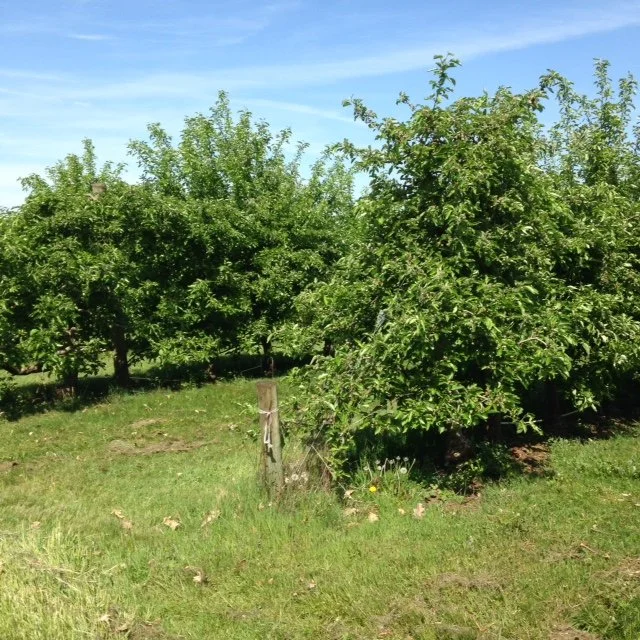




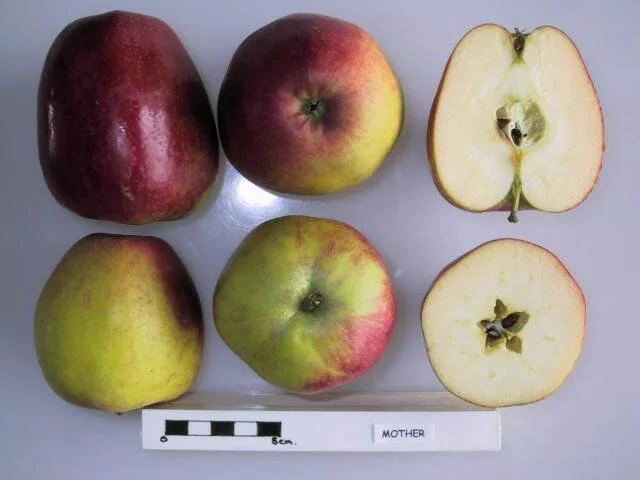

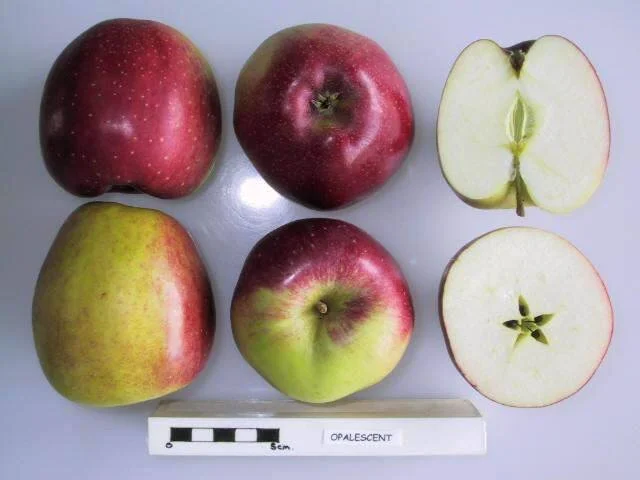
These are sold under the trade marked names of Hidden Rose and Mountain Rose. The original tree was found in the Airlie area of the Willamette Valley of Oregon. They are quite productive and vigorous but somewhat scab prone. These are more pink than red inside with nice pale green skin.
Categories: Red Flesh, dessert apple, cider apple
Tags: Heavy producer, Harvest period late, Pollination Group D